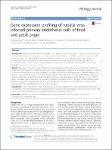Gene expression profiling of rubella virus infected primary endothelial cells of fetal and adult origin
Geyer, Henriette
Bauer, Michael
Neumann, Jennifer
Lüdde, Amy
Rennert, Paul
Friedrich, Nicole
Claus, Claudia
Perelygina, Ludmilla
Mankertz, Annette
Background: Rubella virus (RV) infection is usually a mild illness in children and adults. However, maternal infection during the first trimester of pregnancy can lead to congenital rubella syndrome (CRS) in the infant. Fetuses with CRS show damage to the endothelium of the heart and blood vessels; thus, it has been speculated that the clinical manifestations associated with CRS may be a result of endothelial cells persistently infected with RV. Here, we compared the effects of RV infection on gene expression in primary endothelial cells of fetal (HUVEC) and of adult (HSaVEC) origin by transcriptional profiling. Results: More than 75 % of the genes differentially regulated following RV infection were identical in both cell types. Gene Ontology (GO) analysis of these commonly regulated genes showed an enrichment of terms involved in cytokine production and cytokine regulation. Increased accumulation of inflammatory cytokines following RV infection was verified by protein microarray. Interestingly, the chemokine CCL14, which is implicated in supporting embryo implantation at the fetal-maternal interface, was down-regulated following RV infection only in HUVEC. Most noticeably, when analyzing the uniquely regulated transcripts for each cell type, GO term-based cluster analysis of the down-regulated genes of HUVEC revealed an enrichment of the GO terms “sensory organ development”, “ear development” and “eye development”. Conclusion: Since impairment in vision and hearing are the most prominent clinical manifestations observed in CRS patients, the here detected down-regulated genes involved in the development of sensory organs sheds light on the molecular mechanisms that may contribute to the teratogenic effect of RV.
No license information

